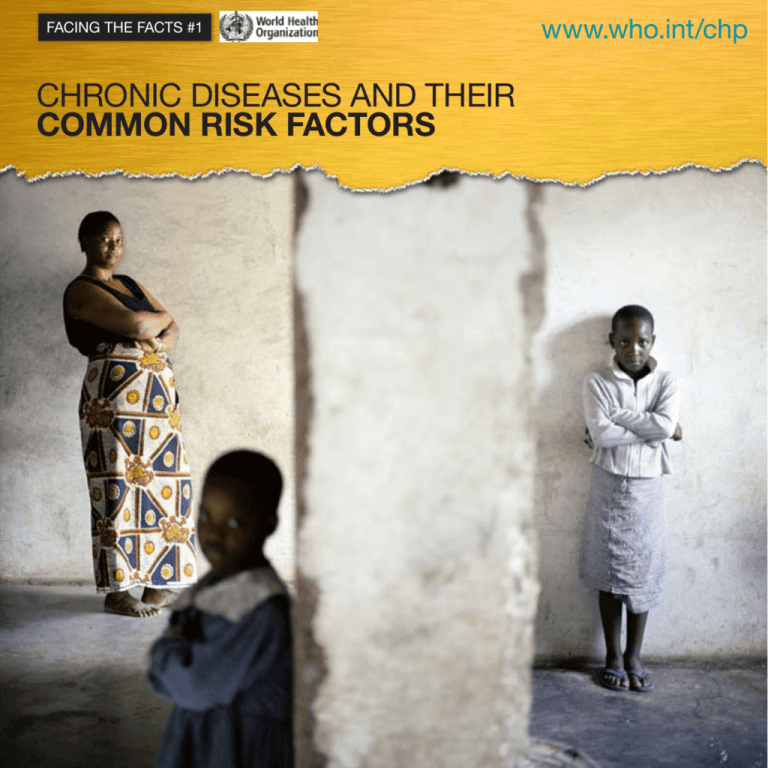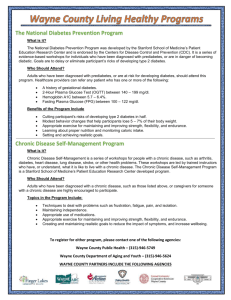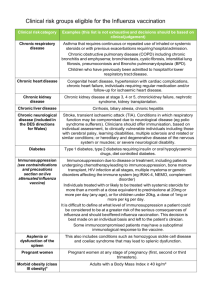Chronic Diseases and their Common Risk Factors.
advertisement

Facing the facts #1 Chronic diseases and their common risk factors www.who.int/chp Chronic diseases are the major cause of death and disability worldwide Stroke Facts Chronic diseases are the major cause of death and disability worldwide. » Chronic diseases will take the lives of over 35 million people in 2005, including many young people and those in middle age. » The total number of people dying from chronic diseases is double that of all infectious diseases (including HIV/AIDS, tuberculosis and malaria), maternal and perinatal conditions, and nutritional deficiencies combined. » 80% of chronic disease deaths occur in low and middle income countries and half are in women. » Without action to address the causes, deaths from chronic disease will increase by 17% between 2005 and 2015. Projected main causes of death, What are chronic diseases? worldwide, all ages, 2005 » cardiovascular diseases, mainly heart disease and Stroke is a disease of the brain caused by interference to the blood supply. Stroke and heart disease are the main cardiovascular diseases. Cancer Cancer describes a range of diseases in which abnormal cells proliferate and spread out of control. Other terms used are tumours and neoplasms. There are many types of cancer and all organs of the body can become cancerous. Chronic respiratory diseases Diseases of the lung take many forms. Chronic obstructive respiratory disease and asthma are the most common forms. stroke; Communicable diseases, maternal and perinatal conditions, and nutritional deficiencies 30% Cardiovascular diseases 30% TOTAL DEATHS 2005 58 million Injuries 9% Other chronic diseases 9% Diabetes Chronic 2% respiratory diseases 7% » cancer; » chronic respiratory diseases; » diabetes; » others, such as mental disorders, vision and hearing impairment, oral diseases, bone and joint disorders, and genetic disorders. Heart disease Cancer 13% There are many forms of heart disease. Coronary heart disease, also known as coronary artery disease or ischaemic heart disease, is the leading cause of death globally. It is caused by disease of the blood vessels (atherosclerosis) of the heart. Chronic obstructive respiratory disease is caused by irreversible obstruction of the larger airways in the lung; asthma is caused by reversible obstruction of the smaller airways in the lung. Diabetes Diabetes is characterized by raised blood glucose (sugar) levels. This results from a lack of the hormone insulin, which controls blood glucose levels, and/or an inability of the body’s tissues to respond properly to insulin. The most common type of diabetes is type 2, which accounts for about 90% of all diabetes and is largely the result of excessive weight and physical inactivity. The usual childhood form of diabetes (type 1 diabetes) is caused by an absolute lack of insulin. Without insulin, type 1 diabetes is rapidly fatal. Causes of chronic diseases underlying Socioeconomic, cultural, political and environmental determinants Globalization Urbanization Population ageing Common modifiable risk factors Intermediate risk factors Main chronic diseases Unhealthy diet Raised blood pressure Heart disease Physical inactivity Raised blood glucose Stroke Tobacco use Abnormal blood lipids Cancer Non-Modifiable risk factors Overweight/obesity Chronic respiratory diseases Age Heredity Diabetes What causes chronic diseases? The causes (risk factors) of chronic diseases are well established and well known; a small set of common risk factors are responsible for most of the main chronic diseases. These risk factors are modifiable and the same in men and women: » unhealthy diet; » physical inactivity; » tobacco use. These causes are expressed through the intermediate risk factors of raised blood pressure, raised glucose levels, abnormal blood lipids, overweight and obesity. The major modifiable risk factors, in conjunction with the non-modifiable risk factors of age and heredity, explain the majority of new events of heart disease, stroke, chronic respiratory diseases and some important cancers. The relationship between the major modifiable risk factors and the main chronic diseases is similar in all regions of the world. Other risk factors © World Health Organization, 2005 Photo: Chris De Bode Many more risk factors for chronic diseases have been identified, but they account for a smaller proportion of disease. Harmful alcohol use is an important contributor to the global burden of disease but its relationship to chronic disease is more complex. Other risk factors for chronic disease include infectious agents that are responsible for cervical and liver cancers, and some environmental factors, such as air pollution, which contribute to a range of chronic diseases including asthma and other chronic respiratory diseases. Psychosocial and genetic factors also play a role. Childhood risk There is now extensive evidence from many countries that conditions before birth and in early childhood influence health in adult life. For example, low birth weight is now known to be associated with increased rates of high blood pressure, heart disease, stroke and diabetes. Risk accumulation Ageing is an important marker of the accumulation of modifiable risks for chronic disease: the impact of risk factors increases over the life course. Underlying determinants The underlying determinants of chronic diseases are a reflection of the major forces driving social, economic and cultural change – globalization, urbanization, population ageing, and the general policy environment. Poverty Chronic diseases and poverty are interconnected in a vicious circle. At the same time, poverty and worsening of already existing poverty are caused by chronic diseases. The poor are more vulnerable for several reasons, including greater exposure to risks and decreased access to health services. Psychosocial stress also plays a role. Without action to address the causes, deaths from chronic disease will increase by 17% over the next ten years







